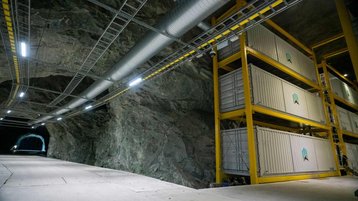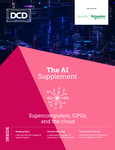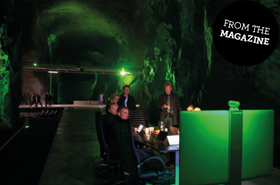The battle to build the world’s largest GPU clusters has primarily been fought in the US. China too has begun to deploy vast compute centers, despite sanctions on imports of crucial components.
But Europe, one of the largest traditional data center markets, has been left behind. “I don’t know why people have been slow to build AI data centers in Europe,” Karl Harvard, managing director of Taiga Cloud, tells DCD. “We saw the opportunity, and we grabbed it.”
Taiga already has thousands of Nvidia A100 and A6000 GPUs deployed, and “by the end of this year we'll have 20,000 plus H100 GPUs live in Europe,” Harvard claims. This would give Taiga one of the largest compute clusters on the continent. “There are others emerging now, which is great - we need that competition here,” Harvard says.
The company is a subsidiary of Northern Data, a German-based Bitcoin mining company that hopes to expand into AI, HPC, and colocation, swapping the turbulent world of crypto for the rollercoaster of generative AI.
“The scale of investment we've made is significant,” Harvard says. “It puts us in a position where we are the largest and cleanest generative AI cloud in Europe. We're trying to operate like larger public clouds, adding the right software and services to help organizations achieve outcomes from generative AI, offering things like training-as-a-service.”
While Harvard and Taiga are focused on bringing GPUs online and building the software for customers, a separate division at Northern - Ardent - is focused on the actual data centers. “We support him [Harvard] in finding homes for his machines,” Corey Needles, Ardent’s managing director, says.
Of the relationship with Taiga, Needles says: “We want them to be in our facilities, and be a good anchor tenant for us - but at arm's length, where we treat them like regular customers.”
Taiga currently operates out of two data centers. In Norway, it is deployed in Lefdal Mine Datacenter, a former olivine mine that is used by cryptominers, Daimler, and Norway's government. Its second facility is in Sweden, where Northern Data acquired Hydro66’s crypto data center in Boden.
“We're still figuring out the math,” Needles says. “Because a crypto site that's 55MW on a piece of fixed land is not going to be 55MW Tier III - it's going to be half of that, if not less, for all the infrastructure. And at this density, I'm going to have to put 22MW of infrastructure in the ground.”
It’s not clear how many of Northern Data’s current data centers (it says it operates 11 facilities) can or will be converted to support enterprise-grade AI deployments. In 2020, when shares in the business were at their peak, Twitter/X users claimed that Northern was overstating its move beyond crypto, causing its valuation to drop dramatically. The company promptly tried to sue Twitter, and its share price has never returned.
A year later, Northern sold most of its US Bitcoin operations, including its facility in Rockdale, Texas, one of the world's largest Bitcoin mining data centers. But it has not quit crypto, with subsidiary Peak Mining continuing to operate in the United States, Canada, and Europe.
Perhaps the biggest reason for the company’s aggressive shift to expand cloud services in the past year is revealed in its latest economic report to investors.
“Following the merge of the Ethereum cryptocurrency from proof-of-work to another consensus mechanism called proof-of-stake in September 2022, after a period of uncertainty as to when it should happen, revenue from Ethereum mining fell to zero,” the report says.
“Accordingly, Northern Data increasingly began to shift part of the freed-up GPU computing capacity to the cloud computing business, which was recognized in the Hardware & Other segment in fiscal year 2022. The hardware for which no alternate use was decided upon by management was impaired as of December 31, 2022.”
As Ardent develops its data center portfolio in Europe and beyond, it will likely deploy both crypto and AI facilities, with the latter using Taiga as an anchor tenant.
“We’re in the market for 30MW plus,” Needles says. “Pittsburgh was 30MW, and we acquired that and we're in the middle of building that out. Scotland will be 32MW, we're in engineering with that. And then we have a bunch [planned in] London, Milan, Frankfurt, Amsterdam.”
He adds: “If there's a deal to be had for somewhere with critical power, we're going after it.”
The company has letters of intent “for multiple facilities that we will repurpose, and then it'll be a powered shell, powered dirt, or landbank environment,” he says. “When the power station gets there, we'll start building. We're just gonna have to scrap to get what facilities we can find - 30MW there, 40MW here.”
Ardent and Taiga are facing the same challenge as the rest of the sector - there is simply not enough available power to meet the demand.
"If there's somewhere with power, there's going to be a war for that," Needles says. "But the price per kW to deploy in a data center is going to go through the roof. In this day and age where you can find power and a good opportunity, if I can get a piece of land that I can put some cows on until it's time, then great."
The hope is that Taiga will be in every Ardent data center - and if its demand outpaces Ardent, "we'll use colo which will be painful, because the margins on the colo for people who can handle above 50kW - and there's not a lot in Europe - are not great," Needles says.
At the same time, Ardent hopes to serve more than just Taiga. "I'd like to have eight or nine customers with big deployments, really dense deployments, and do a really good job of taking care of them," Needles says.
"When I started, it was half cabinet, single cabinet, then cages, and then rooms and then buildings," he recalls, having spent years at Latisys, Zayo, and Internap. "Here, it's just 'let's manage this to where we understand what they want with the technology and the density.’"
The company has embraced liquid cooling, and is only targeting high-density. "The current design is around 50kW, the next couple of deployments will start to rise probably into the hundreds," he says. "The way we're designing it is to eventually be able to handle 256kW and beyond. My data centers are going to be small, they're going to be dense."
At Taiga, Harvard, who counts AWS and Google Cloud among his former employers, hopes that only having dense data centers will allow the company to focus on the workloads of tomorrow. "If you look at the public clouds they do have legacy data centers all over," he says. "They've got a big job on their hands to make them fit for purpose for gen AI."
The hyperscalers’ European facilities are even further behind, as their focus has been on building out US-based AI sites. This, in part, reflects the vagaries of the supply chain, with both execs suggesting that Nvidia prioritized US GPU shipments.
"We're starting to see the supply chain sort itself out," Harvard says. "We placed a large order with Nvidia and expected a slight delay, but actually they bought it forward."
That "wreaked havoc on deployment plans," he adds, with a laugh. "But we'll support it."



